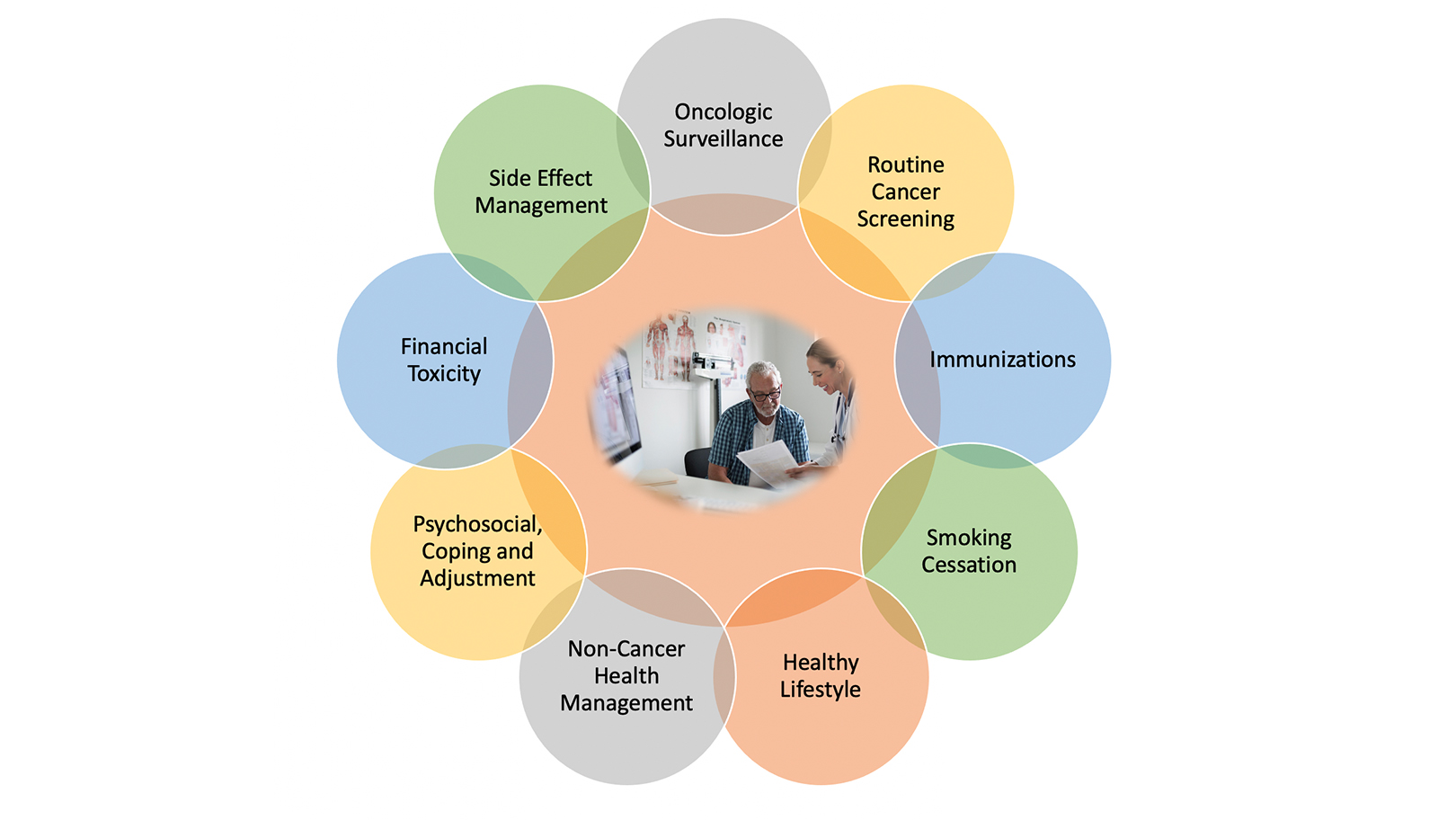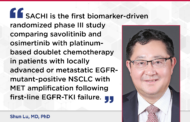Lung cancer is one of the most common cancers worldwide, with more than 2 million people diagnosed each year.1 Advances in early detection and treatment have resulted in more people surviving the disease. Nevertheless, in the United States, the overall 5-year survival rate is only 19% for all stages combined. However, in patients with localized disease, survival rates are much higher, at approximately 57%.2 Increased use of CT screening for lung cancer has resulted in many more patients being diagnosed with stage I tumors, which have a 90% rate for 5-year survival.3 As early-detection efforts increase, coupled with further advances in systemic therapies, we can expect to have many more patients living long lives after a lung cancer diagnosis. It is important to consider how the long-term and late effects of treatment increase the risk of certain comorbidities and how they affect quality of life (QOL) for these survivors. How can we as providers improve the care of survivors and have a positive impact on their lives?
Surveillance and Healthy Living
Professional guidelines recommend that all survivors should have oncologic surveillance following treatment, for the detection of recurrence. Lung cancer survivors have a higher risk of developing a second primary lung cancer when compared to the general population, and this risk persists for many years after treatment.4,5 Surveillance for other cancers is particularly important in current or former smokers, because these patients are also at risk for other smoking-related cancers, including bladder, head and neck, esophageal, and pancreatic cancers. Survivors who continue to use tobacco should be counseled regarding cessation and referred to a cessation program for support. In addition, survivors should undergo all age-appropriate cancer screenings.
The National Comprehensive Cancer Network guidelines for survivorship care include recommendations for immunizations (annual flu vaccination, pneumococcal vaccination and re-vaccination as appropriate, and zoster vaccination). Survivors should be counseled on maintaining a healthy weight, having a physically active lifestyle, limiting alcohol intake, and consuming a healthy diet with an emphasis on plant sources. Survivors should continue to see their primary care provider for routine monitoring and management of non-oncologic health.6
Long-Term and Late Effects
Lung cancer is commonly treated with surgery, radiation therapy, chemotherapy, and immunotherapy. These treatments can lead to long-term effects (those that continue after treatment) or late side effects (those that occur months to years after treatment). Persistent symptoms can affect a survivor’s physical functioning, mental health, QOL, and ability to engage in exercise, which has been shown to improve QOL (Table).
| Long Term or Late Effect | Contributing Therapies and Other Factors | Survivor Experience |
|---|---|---|
| Fatigue |
All therapies |
Affects 90% of survivors and can last for many years.7 |
| Post-thoracotomy pain syndrome | Surgery | Can contribute to depression, anxiety, and sleep problems. |
| Impaired pulmonary function (dyspnea, cough) |
Surgery Radiation therapy Underlying lung disease |
Occurs in up to 60% of early-stage survivors, and persists up to 6 years for some.8
Can interfere with ability to perform ADLs and with quality of life. |
| Lung complications (pneumonitis, fibrosis, cough) |
Radiation therapy | Affects daily activities and quality of life. |
| Neurocognitive effects | Taxanes Platinum-based therapy |
Occurs in 45% of survivors.9 |
| Hearing loss | Platinum-based therapy | Occurs in 21% of survivors. Can persist up to 30 months after treatment.9 |
| Immune-mediated toxicity (pneumonitis, colitis, skin reactions, hormone and vision changes, etc.) |
Immune therapies | These effects are acute, but the long-term effects of these medications are not yet known. |
| Cardiovascular disease and stroke |
|
More common in lung cancer survivors than in their peers.10,11 |
Adding to concerns of these late and long-term effects is the fact that approximately 75% of lung cancers occur in individuals age 65 and older.12 These patients are more likely to have other comorbidities that accentuate the adverse effects of treatment, negatively affecting QOL.
Psychosocial and Practical Concerns
Studies have found that patients with lung cancer experience higher levels of cancer-related distress as a result of anxiety, fear of recurrence, the stigma associated with the diagnosis, survivor guilt, physical disability, and financial concerns.5,13 Extended treatment time with targeted oral oncolytics can be a financial burden for survivors who have limited or no prescription drug coverage, especially those age 65 or older or on long-term disability with Medicare part D. This burden is associated with decreased adherence and inferior survival.14
Survivorship Care Planning
Given the range of concerns and late effects that survivors of lung cancer may face, a survivorship care plan (SCP) can provide much-needed guidance and support. An SCP is a “patient-facing” document meant to educate and support the survivor. OncoLife is a free tool that can be used to generate an SCP on the basis of the survivor’s cancer-treatment history. This tool has been used since 2007 to create more than 98,000 care plans. OncoLife’s SCP provides information on long-term and late effects, oncologic follow-up care, healthy living, and psychosocial and practical concerns. Providing this information through an SCP can reduce distress and support the transition to survivorship.
Survivors of lung cancer experience a number of needs that require ongoing care to maximize QOL. Collaboration among interprofessional teams is essential to meet the ongoing needs of survivors living with and after lung cancer treatment.
References:
- Bray F, Ferlay J, Soerjomataram I, Siegel RL, Torre LA, Jemal A. Global cancer statistics 2018: GLOBOCAN estimates of incidence and mortality worldwide for 36 cancers in 185 countries. CA: Cancer J Clin. 2018;68(6):394-424.
- Miller KD, Nogueira L, Mariotto AB, et al. Cancer treatment and survivorship statistics, 2019. CA: Cancer J Clin. 2019;69(5):363-385.
- International Early Lung Cancer Action Program Investigators; Henschke CI, Yankelevitz DF, et al. Survival of patients with stage I lung cancer detected on CT screening. NEJM. 2006;355(17):1763-1771. Published corrections appear in: NEJM:2008;358(17):1862. NEJM:2008;358(17):1875. NEJM:2008;359(8):877.
- Barclay ME, Lyratzopoulos G, Walter FM, Jefferies S, Peake MD, Rintoul RC. Incidence of second and higher order smoking-related primary cancers following lung cancer: a population-based cohort study. Thorax. 2019;74(5):466-472.
- Pozo CLP, Morgan MAA, Gray JE. Survivorship issues for patients with lung cancer. Cancer Control. 2014;21(1):40-50.
- National Comprehensive Cancer Network. NCCN clinical practice guidelines in oncology: non-small cell lung cancer. 2020. Accessed February 4, 2021. https://www.nccn.org/professionals/physician_gls/pdf/nscl.pdf
- Alfano CM, Rowland JH. Recovery issues in cancer survivorship: a new challenge for supportive care. Cancer J. 2006;12(5):432-443.
- Feinstein MB, Krebs P, Coups EJ, et al. Current dyspnea among long-term survivors of early-stage non-small cell lung cancer. J Thor Oncol. 2010;5(8):1221-1226.
- Bezjak A, Lee CW, Ding K, et al. Quality-of-life outcomes for adjuvant chemotherapy in early-stage non-small-cell lung cancer: results from a randomized trial, JBR.10. J Clin Oncol. 2008;26(31):5052-5059.
- Armenian SH, Xu L, Ky B. Cardiovascular disease among survivors of adult-onset cancer: a community-based retrospective cohort study. J Clin Oncol. 2016;34(10):1122.
- Yoon DW, Shin DW, Cho JH. Increased risk of coronary heart disease and stroke in lung cancer survivors: a Korean nationwide study of 20,458 patients. Lung Cancer. 2019;136(115):121.
- Miller KD, Nogueira L, Mariotto AB. Cancer treatment and survivorship statistics, 2019. CA: Cancer J Clin. 2019;69(5):363-385.
- Perloff T, King JC, Rigney M, Ostroff JS, Johnson Shen M. Survivor guilt: the secret burden of lung cancer survivorship. J Psychosoc Oncol. 2019;37(5):573-585.
- Goulart BHL, Unger JM, Chennupati S, Fedorenko CR, Ramsey SD. Out-of-pocket costs for tyrosine kinase inhibitors and patient outcomes in EGFR- and ALK-positive advanced non-small-cell lung cancer. JCO Oncol Pract. 2020. [Epub ahead of print].






